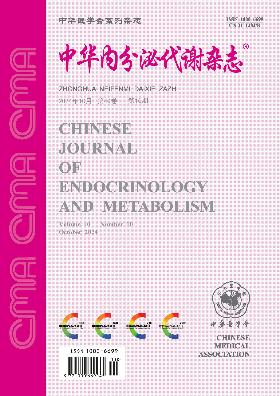欧米伽-多不饱和脂肪酸改善出生后早期过度喂养引起的成年大鼠代谢紊乱
Q4 Medicine
引用次数: 1
摘要
目的探讨ω3-多不饱和脂肪酸(ω3-PUFA)饮食干预对出生后早期过量喂养成年大鼠白色脂肪组织线粒体功能的影响及其机制。方法建立调整产仔数的过饲动物模型,对新生儿过饲进行研究。调整产仔数为每窝3只公鼠(小窝,SL组),每窝10只仔鼠(正常窝,NL组)。断奶后(第3周)饲喂标准饲料或ω3-PUFA日粮(SL-FO),直至出生后第13周。第13周定期测定大鼠的摄食量、体重、直肠温度,并监测动物能量代谢。在第3周和第13周收集皮下脂肪组织。分离小鼠腹股沟前脂肪细胞,诱导其分化,分化后期给予50 μmol/L二十碳五烯酸(EPA) 48 h。检测脂肪组织和脂肪细胞中线粒体相关基因mRNA和蛋白表达水平、线粒体拷贝数和脂肪细胞耗氧量。结果到第3周时,SL组的体重、摄食量、脂肪细胞面积均高于NL组,体温低于NL组,直至13周。到第13周,SL组大鼠的耗氧量、CO2排泄量和产热量均低于NL组。与此同时,线粒体功能相关基因解偶联蛋白1(UCP1)、肉碱棕榈酰基转移酶1(CPT1)、SIRT1及线粒体生物合成调控基因过氧化物酶体增殖物激活受体辅助因子-1 (PGC1α)在第3周和第13周的表达量均显著降低(P<0.05)。断奶后ω3-PUFA饲粮显著降低SL大鼠增重,提高UCP1蛋白表达,恢复能量代谢水平和线粒体功能相关基因表达。EPA体外干预可提高线粒体拷贝数、线粒体生物合成基因和功能基因mRNA和蛋白表达量以及线粒体基本耗氧量(P<0.05)。结论ω3-PUFA可改善大鼠出生后过度喂养引起的线粒体功能和皮下白色脂肪组织生物合成损伤,这可能是鱼油日粮抑制早期过度营养、恢复热代谢的重要机制。关键词:Omega 3-PUFA;产后吃得过多;白色脂肪;线粒体本文章由计算机程序翻译,如有差异,请以英文原文为准。
Omega3-polyunsaturated fatty acid ameliorates metabolic disorders in adulthood rats caused by postnatal early overfeeding
Objective
To explore the effect and mechanism of omega 3-polyunsaturated fatty acid(ω3-PUFA) dietary intervention on mitochondrial function of white adipose tissue in adult rats with postnatal early overfeeding.
Methods
An overfed animal model by adjusting litter size was developed for the study of neonatal overfeeding. The litter size was adjusted to 3 male rats per litter(small litter, SL group) and 10 pups per litter(normal litter, NL group). After weaning(week 3), the pups were fed standard chow or ω3-PUFA diet(SL-FO) until postnatal weeks 13. Food intake, body weight, and rectal temperature of rats were measured regularly, and energy metabolism of animals was monitored in week 13. During week 3 and 13, subcutaneous adipose tissue was collected. Inguinal preadipocytes of mice were isolated and induced to differentiate, and 50 μmol/L eicosapentaenoicacid(EPA) was administered for 48 h at the late stage of differentiation. The mRNA and protein expression levels of mitochondrial related genes, mitochondrial copy number, and oxygen consumption rate of adipocytes were detected in adipose tissue and adipocytes.
Results
By the 3rd week, the body weight, food intake, and fat cell area in SL group were higher than those in NL group while the body temperature was lower until to 13 weeks. By the 13th week, the O2 consumption, CO2 output, and heat production of rats in SL group were lower than those in NL group. Meanwhile, the expressions of mitochondrial function related genes such as uncoupling protein 1(UCP1), carnitine palmitoyltransferase 1(CPT1), SIRT1, and mitochondrial biosynthesis regulatory gene peroxisome proliferator-activated receptor coativator-1 (PGC1α) in adipose tissue by the 3rd and 13th week were significantly reduced(P<0.05). After weaning, ω3-PUFA diet significantly reduced weight gain in SL rats, increased UCP1 protein expression, restored energy metabolism level and mitochondrial function related gene expression. In vitro intervention of EPA increased the mitochondrial copy number, the mRNA and protein expression levels of mitochondrial biosynthesis and functional genes, as well as the mitochondrial basic oxygen consumption rate(P<0.05).
Conclusion
ω3-PUFA improves postnatal overfeeding-induced impairment of the mitochondrial function and biosynthesis of subcutaneous white adipose tissue in rats, which may be an important mechanism for fish oil diet to inhibit the early over-nutrition program and restore the thermogenic metabolism.
Key words:
Omega 3-PUFA; Postnatal overfeeding; White fat; Mitochondria
求助全文
通过发布文献求助,成功后即可免费获取论文全文。
去求助
来源期刊

中华内分泌代谢杂志
Medicine-Endocrinology, Diabetes and Metabolism
CiteScore
0.60
自引率
0.00%
发文量
7243
期刊介绍:
The Chinese Journal of Endocrinology and Metabolism was founded in July 1985. It is a senior academic journal in the field of endocrinology and metabolism sponsored by the Chinese Medical Association. The journal aims to be the "Chinese broadcaster of new knowledge on endocrinology and metabolism worldwide". It reports leading scientific research results and clinical diagnosis and treatment experience in endocrinology and metabolism and related fields, as well as basic theoretical research that has a guiding role in endocrinology and metabolism clinics and is closely integrated with clinics. The journal is a core journal of Chinese science and technology (a statistical source journal of Chinese science and technology papers), and is included in Chinese and foreign statistical source journal databases such as the Chinese Science and Technology Papers and Citation Database, Chemical Abstracts, and Scopus.
 求助内容:
求助内容: 应助结果提醒方式:
应助结果提醒方式:


